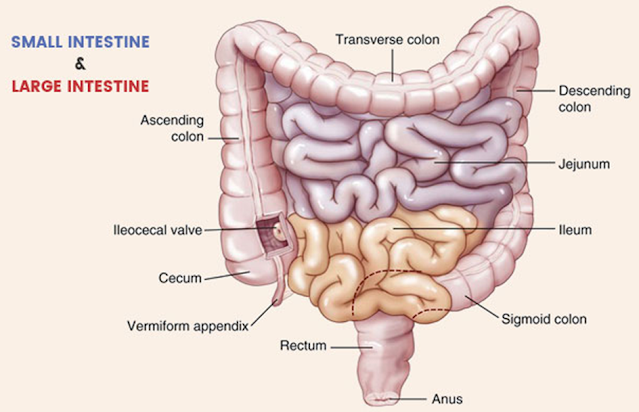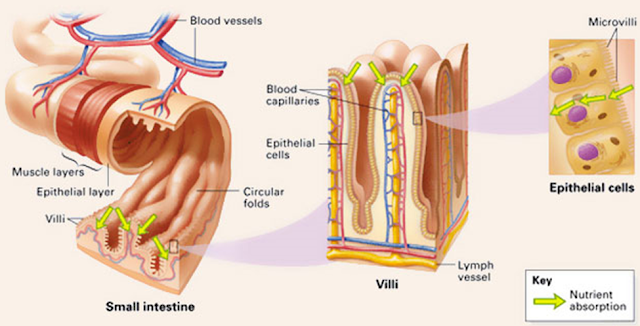[the_ad id=”476″]
The intestines are located between the stomach and the anus and are divided into two major sections: the small intestine and the large intestine. The function of the small intestine is to absorb most ingested food. The large intestine is responsible for absorption of water and excretion of solid waste material.
The intestines are a long, continuous tube running from the stomach to the anus. Most absorption of nutrients and water happen in the intestines. The intestines include the small intestine, large intestine, and rectum.
The small intestine (small bowel) is about 6 metres long and about 2.5cm in diameter. Its job is to absorb most of the nutrients from what we eat and drink. Velvety tissue lines the small intestine, which is divided into the duodenum, jejunum, and ileum.
The large intestine (colon or large bowel) is about 1.5 m long and about 7.6 cm in diameter. The colon absorbs water from wastes, creating stool. As stool enters the rectum, nerves there create the urge to defecate.

SMALL INTESTINE STRUCTURE
The small intestine which, though small in diameter, is the longest part of the gastrointestinal system. “Small Bowel” is one of the commonly used small intestine names.
The organ is responsible for the absorption of over 90% of nutrients from the food. It absorbs more than 95% of the ingested proteins and carbohydrates.

The small intestine starts from the pyloric sphincter at the lower end of the stomach and continues to the beginning of large intestine at the ileocecal junction. It is as big as your middle finger. In other words, it measures around 2.5cm in diameter.
It is easy to find small intestine location in the body. Stretching from the stomach to the cecum of large intestine, the small bowel is located within the central and lower abdominal area. It coils around several times to fit into a small space in the lower abdominal area.
In the small intestine diagram, it is visible between the ascending, transverse and descending part of the colon. It is located more centrally while the large bowel is more towards the periphery. The latter has the diameter of around 6.4 centimetres against 2.5 centimetres lumen of the small intestine.
Small Intestine Vs Large Intestine
The intestines are the hollow muscular tubes, running from the stomach till the anus. As you already know, one of them is called ‘small intestine’ and the other ‘large intestine’ or ‘colon’.
Moving from the mouth to the anus, the small bowel runs from the pyloric sphincter at the end of the stomach till the ileocecal junction. On the other hand, the colon begins at the ileocecal junction and ends at the anus.
The words “small” and “large” attached to the name of intestine can be the source of confusion. The small bowel is small not in terms of length but for its narrow lumen. In fact, it forms the longest part of the gastrointestinal system. On the other hand, the large bowel is not large in terms of length. Actually, it has more than twice the diameter of the small bowel.
The main job of small intestine is to absorb nutrients from the digested food while the colon serves as a temporary storage for the digestive wastes before their discharge out of the body.

Small Intestine Parts
There are three major small intestine parts, namely, duodenum, jejunum and ileum. Moving from the stomach to the large intestine, they appear in the following sequence:
Duodenum ⇒ Jejunum ⇒ Ileum
These segments of the bowel also increase in length in the same sequence. It means duodenum is the smallest and the ileum the largest part. Overall length, however, may be greater in tall persons. It also increases when it is empty and after the individual dies.
There is division of labour among different segments. In other words, each of the small intestine parts must perform a specific assigned task.

Here follows a brief overview of each of these parts.
Duodenum
The first and shortest segment of the small bowel, duodenum connects the stomach to the jejunum. This C-shaped hollow tube measures around a foot in length. Duodenum receives food from the stomach in the form of chyme and mixes it with bile juice and the pancreatic secretions. It neutralises the partially digested food with the help of alkaline mucus containing a high concentration of bicarbonate ions. The mucus is secreted by the Brunner’s glands present only in the duodenum. Sometimes, it may reach the length of 38 centimetres.
The enzymatic secretions help in the digestion of carbohydrates, proteins and fats. So, the process of chemical digestion that started in mouth gets completed here. It also prepares food for absorption in jejunum. You can distinguish duodenum into four different parts. These are:
a. The Superior Part
The superior part is the continuation from the pylorus and lies posterior to all other segments. It lies at the vertebral level of L1. About 2 cm in length, the superior part of duodenum is mobile and ends at the superior duodenal flexure.
b. The Descending Part
The descending part starts at the superior duodenal flexure and descends to reach below L3 level of vertebral body. It ends at the inferior duodenal flexure. The common bile duct and pancreatic duct are attached to the descending section of the bowel at the point of major duodenal papilla.
Through the bile and pancreatic ducts, the intestine receives bile juice and pancreatic secretions.
c. The Horizontal Part
The third part of duodenum is also called the inferior part or the horizontal part. Beginning at the inferior duodenal flexure, it passes in front of the inferior vena cava and the abdominal aorta.
d. The Ascending Part
The fourth and last part of the duodenum passes upward to reach the duodenojejunal flexure where it joins with the jejunum. Lying at the vertebral level L2, it may pass directly on top of the aorta.
Jejunum
Jejunum is the second or middle part of the small intestine. In terms of length, it is longer than duodenum and shorter than ileum. Measuring around 2.4m, the duodenum is as many as 8 times longer than the duodenum.
While duodenum carries out and completes the chemical digestion, jejunum is the principle site for the absorption of nutrients from the digested food. This is the place where over 90% absorption of the foodstuffs takes place.
Though villi or finger-like projections are present across all segments of small bowel, they are longer and more active in jejunum. The epithelial cells, lining the villi, also have microvilli. The folds in the epithelium, villi and microvilli collectively contribute to incredibly increase the surface area for absorption.
Nutrients move across the epithelium of jejunum and ileum with the help of active or passive transport. Small peptides, amino acids, vitamins and glucose are actively transported. Fructose, on the other hand, moves through the passive transport.
The pH is between 7 and 9 which means the medium is neutral or slightly alkaline. The suspension of the jejunum by mesentery in the abdominal area renders it sufficient mobility. Meanwhile, the circular and longitudinal layers of smooth muscles in the intestinal wall generate peristaltic movements. Peristalsis helps in the pushing of foodstuffs towards the posterior end of the gastrointestinal tract.
Ileum
The third and longest segment of small bowel, ileum runs for the length of 3.7 metres, accounting for three-fifths the length of the small intestine. Continuous with the jejunum, it ends at the ileocecal valve which separates it from the cecum. Mesentery, a fold of the serous membrane, suspends ileum from the abdominal wall.
The layers of longitudinal and smooth muscles in the ileal wall are thinner than those of other parts of small intestine. So, the peristaltic contractions are slower. Also its lining is less permeable than that of the preceding small intestine parts.
Regarding its role in digestive system, the ileum contains receptors for absorption of vitamin B12 and bile salts. Meanwhile, it also absorbs the leftover nutrients from the digested food. Ileum absorbs about 95% of the conjugated bile salts from the intestinal contents.
Hans Conrad Peyer, a Swiss anatomist, discovered bundles or patches of lymphatic cells in ileum. These patches are named after him as Peyer’s patches. You can see them by the human naked eye as elongated thickened areas without villi. Every individual has 30 to 40 such patches in their intestine.
Small Intestine Functions in Digestive System
A long, hollow, narrow and folded tube, the small intestine is the principle organ of the digestive system. It is the site for most digestion and absorption of food you eat. Apart from digestion and absorption, it performs several other tasks as well.

Some of the important small intestine functions are discussed below:
Neutralisation
The semi-digested food or chyme, coming from the stomach, is highly acidic in nature. It needs to be neutralised for the optimum activity of intestinal enzymes.
How is acidic chyme neutralised in the duodenum of small intestine? Duodenum, the first segment of small bowel, secretes a hormone, secretin. This hormone causes the pancreas secrete large amounts of sodium bicarbonate. Sodium bicarbonate raises the pH of chyme from 2 to 7. Meanwhile, the mucus and bile juice also has a neutralising effect.
Protection from Acids
The pH of the acidic chyme, expelled from the stomach to the small intestine, is 2. It can damage the wall of small bowel. Now it is the job of small intestine to protect itself from such damage. The goblet cells in the intestinal epithelium secrete mucus which forms a layer to save the intestinal wall from luminal contents.
Protection from Microbes
There are anti-microbial cells (Paneth cells) in the epithelial wall of the bowel. The Paneth cells secrete anti-microbial peptides which kill harmful microbes in the luminal contents.
Emulsification of Fats
As chyme enters the duodenum from stomach, bile is released by the gallbladder. The bile juice emulsifies and breaks down the fats into small particles, thus aiding in the mechanical digestion of fats.
Mechanical Digestion
The contractions of circular muscles in the intestinal wall facilitate the mechanical breakdown of the food. Through these contractions, the foodstuffs are mixed with secretions from pancreas and gallbladder. Meanwhile, the large food particles reduce to smaller ones.
Chemical Digestion
Duodenum not only mechanically breaks down the food but also digests it chemically. The secretions of liver, pancreas and bowel help in the chemical breakdown of the carbohydrates, lipids and proteins.
Absorption of Nutrients
Small intestine plays a key role in the absorption. In fact, it absorbs about 95% of all the useful substances from the food, including ions, amino acids, glucose, small peptides, lipids, water, vitamins, fructose, iron and bile salts.
Absorption of iron takes place in the duodenum and the terminal ileum takes up bile salts and vitamin B12. The remaining nutrients are absorbed by jejunum through either diffusion or active transport.
Bowel Movements
Among other crucial functions, the small intestine also helps in the bowel movements to expel digestive waste towards the posterior end of the digestive tract for its ultimate removal out of the body. The coordinated contractions of circular and longitudinal smooth muscle fibres in the intestinal wall not only help in the mixing of foodstuffs with secretions but also facilitate bowel movements along the lumen.
Role in Immunity
The small intestine also supports your body’s immune system. The probiotic gut flora has a positive and supportive effect on the defence system of your body. The ileum contains Peyer’s patches which are an important part of the local immune system of the gastrointestinal system. The lymphocytes present in the Peyer’s patches are a part of the lymphatic system.
Small Intestine Diseases
Small intestine is the principle digestive organ. It not only serves as a site for most of the digestion and absorption of food but also has a role in immunity and performs several other functions. So, a small intestine disease can adversely affect one or more of the functions of the organ.

Some of the small intestine disorders include cancer, ulcer, celiac disease, intestinal obstruction, intestinal lymphoma, tropical sprue, lactose intolerance, and so on. Discussed below are causes, symptoms and treatment of common intestinal disorders.
Small Bowel Obstruction
Small bowl obstruction refers to the partial or complete blockage of small bowel. Such a condition impedes the normal passage of luminal contents through the small intestines. This potentially dangerous condition can seriously affect the quality of your life.
Causes
Small bowel obstruction may occur due to multiple reasons, for example, cancer, internal scar tissue and strangulated hernia. A strangulated hernia is a protruding portion of the small intestine that comes out through a weak spot in the abdominal wall.
Symptoms
- Bouts of painful muscle contractions after intervals.
- Painful abdominal swelling which increases with time.
- Progressive constipation and inability to pass faeces or even gas.
- diarrhoea due to partial obstruction.
- Nausea leading to vomiting.
- Low-grade fever and weakness.
Celiac Disease
The celiac disease, also called celiac sprue, is a digestive disorder that is more common in people of European descent than in others. It may cause diarrhoea, weight loss, fatigue and pain in bones.
Causes
Celiac disease is a condition that results from gliadin protein found in gluten. Gluten is a component of wheat that renders smoothness and elasticity to the flour. The presence of gluten in food produces an immune reaction. Such an immune reaction causes a damage to the lining of the small intestine.
Discover more from Centre for Elites
Subscribe to get the latest posts sent to your email.
